How to Integrate eCommerce SEO & PPC to Increase Sales
Are SEO and PPC better off alone, siloed into their respective search disciplines or can they really do much more as a team?

From working on over 350 search marketing campaigns at ThoughtShift, we’ve seen both sides of the story.
The cons of being apart
The main complaint we’ve heard from brands whose SEO and PPC campaigns are managed by independent teams is that there is often “blame-shifting” between teams when things don’t go to plan.
We’ve found this is often caused by each channel cannibalising the other’s results, making it difficult to compare like for like.
The paid team are targeted to increase return on ad spend and increase sales so they bid on every brand term available, sometimes when there are no competing paid ads. The organic team are targeted to increase traffic and sales and make decisions to target keywords based on potential traffic volumes, without using the paid keyword conversion data available in the Google AdWords account - easily identified by the AdWords account not being linked to the Google Analytics.
The pros of being together
For multiple brands we’ve worked with where their SEO and PPC campaigns were previously managed separately, we’ve found their brand visibility, traffic, revenue and total return on investment dramatically improve by integrating their campaigns into one audience-led search engine marketing strategy.
For one retailer in particular, utilising conversion insights from their existing Google AdWords account to not only restructure their PPC campaigns, but also to create their SEO Strategy, led to their online business growing from a 7 figure turnover to a 8 figure turnover within a year.

So what’s involved in integrating eCommerce SEO & PPC?
A lot of people assume putting two seemingly very similar search marketing specialisms together is easy.
In reality, it’s a bit like trying to blend oil and water – until that is, you bring in a new team member into the mix, Digital Marketing Strategy.
What eCommerce SEO and PPC both have in common is they are involved at every step of the customer buying journey, from awareness, through consideration and on to purchase.
So by approaching eCommerce SEO and PPC integration by putting your ideal customer at the heart of everything you do, you circumvent thinking in vertical channels alone and bring decision making to a strategic and horizontal level instead.
That’s why our ThoughtShift Digital Marketing Methodology is based on Audience Insight first, which then informs a unique Content Strategy for both organic and paid media (often using the same landing pages to get the benefits for both channels at the same time, meaning more landing pages can be optimised for both campaigns with far fewer resources), with the tactical execution implemented by both SEO and PPC specialists by Testing Campaigns.
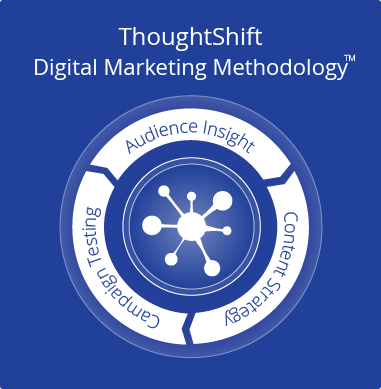
Integrating eCommerce SEO & PPC Phase 1: Audience Insight
So for the first phase, Audience Insight, you need to gather existing data from Google Analytics and Google AdWords to then enable your current performance to be analysed and digital marketing insights to be created. There's a lot of data to discover, which is why it is so critical to be monitoring this data using the correct Google Analytics eCommerce Tracking set up.
Here's a list of reports to review, ideally comparing year on year to account for seasonality, or month on month if that longer term data isn't available (but always considering the likely performance differences between months if peak trading periods are involved, such as when comparing January including discounted sales to December including inflated Christmas conversion rates).
Performance Data Discovery
Paid search revenue
Google Analytics > Acquisition > All Traffic > Channels > Paid Search (Compare Preferred Date Range)
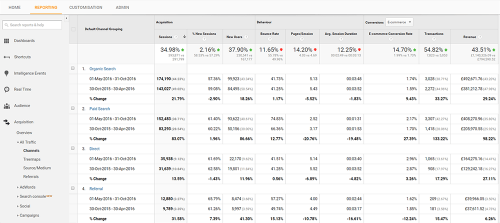
Paid search revenue by keyword
Google Analytics > Acquisition > AdWords > Keywords (View Preferred Date Range, Sort by Revenue)
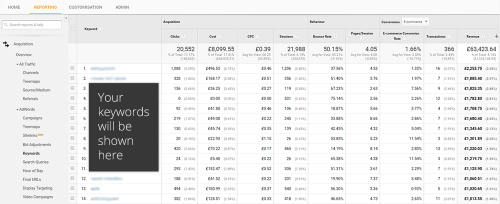
Paid search revenue by product
Google Analytics > Conversions > E-commerce > Product Performance (View Preferred Date Range, Filter by Google PPC or Paid Traffic Segment, Sort by Revenue)
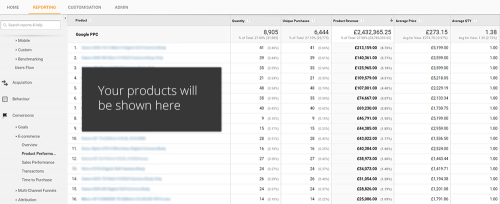
Paid search impression share by keyword
Google AdWords > Reports > Search Keyword + Search Impression Share + Conversions > (View Preferred Date Range, Sort by Conversions)
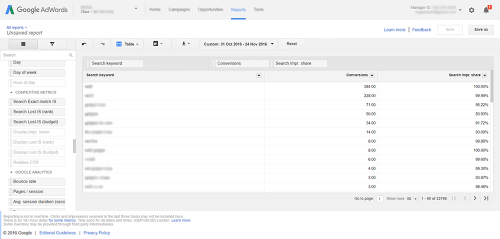
Organic search revenue
Google Analytics > Acquisition > All Traffic > Channels > Organic Search (Compare Preferred Date Range)
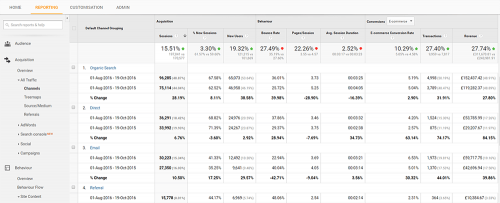
Organic search revenue by landing pages
Google Analytics > Behaviour > Site Content > Landing Pages (View Preferred Date Range, Filter by Organic Traffic, Sort by Revenue)
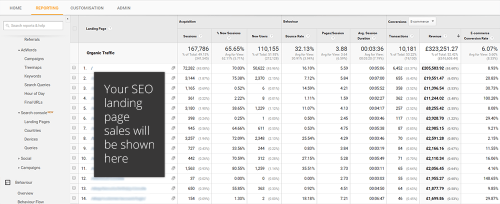
Organic revenue by products
Google Analytics > Conversions > E-commerce > Product Performance (View Preferred Date Range, Filter by Organic Traffic Segment, Sort by Revenue)
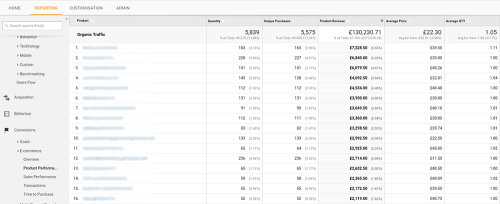
Organic rankings by keyword
Google Analytics > Acquisition > Search Console (Must Be linked to Your Analytics) > Queries (View Preferred Date Range, Sort by Clicks)
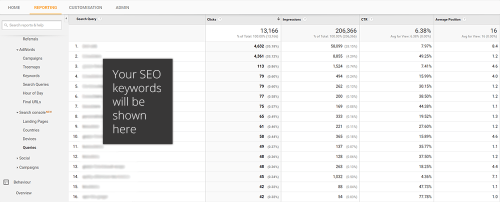
Performance Analysis
Once you've gathered all your data, it's time to analyse it and ask the following questions:
- Which paid campaigns have driven the highest volume of sales?
- Which paid keywords have driven the highest volume of sales?
- Which product sales from paid search have driven the highest volumes of sales?
- Which keywords have an impression share of <100% and have also sent paid revenue?
- Which keywords have an impression share of <100% and have the highest conversion rates?
- Which keywords have an impression share of <100% and have the highest average order values?
- Which product sales from organic search have driven the highest volumes of sales?
- Which landing pages from organic search have driven the highest volume of sales?
- Which page 1 keyword rankings correlate with the top organic revenue driving pages and products?
- Which keywords appear to be driving product/page revenue that relate to SEO campaign work?
Performance Insights
You know you've answered all the performance analysis questions when you can complete the following list of PPC and SEO insights:
PPC Insights
- Top PPC campaigns driving revenue
- Top PPC revenue driving keywords
- Top PPC products driving revenue
- Best PPC revenue gap keywords (not appearing at the top of Google 100% of the time)
- Best PPC conversion rate gap keywords (not appearing at the top of Google 100% of the time)
- Best PPC average order gap keywords (not appearing at the top of Google 100% of the time)
- Best short term PPC revenue keyword opportunities from all best conversion sources including PPC and SEO (not appearing at the top of Google and with the biggest opportunity to increase revenue if the cost per click were to be maintained)
SEO Insights
- Top SEO products driving revenue
- Top SEO pages driving revenue
- Best SEO revenue opportunities from PPC top performing keywords (not at top of page 1)
- Best SEO revenue opportunities from PPC top performing products (not at top of page 1)
- Best SEO revenue opportunities from SEO top performing pages (not at top of page 1)
- Best SEO revenue opportunities from SEO top performing products (not at top of page 1)
- Best short term SEO revenue keyword opportunities from all data sources including SEO and PPC (not at page 1 AND where the annual revenue generated is worth multiple times more than the campaign investment required AND where the domain authority score of the competitor pages ranking on page 1 is less than a gap of 15 domain authority score points)
Integrating eCommerce SEO & PPC Phase 2: Content Strategy
The Content Strategy phase draws upon the performance insights gained in the first phase to create paid media, onsite content and offsite content marketing strategies using both SEO and PPC data.
Paid Media Campaign Strategy
- Shift paid media budget to top revenue driving Google Shopping Campaigns
- Shift paid media budget to top revenue driving Google AdWords Campaigns
- Optimise existing and create new ad groups for the best PPC revenue driving keywords using budget saved from lowest performing PPC campaigns
- Optimise existing and create new ad groups for the best SEO revenue keyword opportunities using budget saved from lowest performing PPC campaigns
- Create 2 versions of ad copy for all ad groups to A/B test using previous best performing ad copy
- Optimise the existing shopping feed or set up a shopping feed for all available products, adding negative keywords to the best sales driving products
Onsite Content Strategy
- Review top landing pages and product pages driving revenue to identify if there are content gap opportunities to apply keyword variations (relevant to each particular page) from the top revenue driving PPC keywords to any of the following whilst maintaining the current positions of all organic ranking keywords across:
- title tags
- meta descriptions
- main headings
- body content
- internal links
- Ensure that no organic keywords currently ranking on page 1 and likely to be sending revenue due to the correlating top SEO landing pages and product pages have been moved further to the right or down the page as this will potentially reduce those rankings and subsequent revenue.
- Benchmark Google AdWords Quality Score for campaigns where the organic landing pages optimised match destination URLs used in paid media campaigns
Offsite Content Marketing Strategy
- Create an offsite content marketing strategy for the target list of best short term SEO revenue driving keywords including a mix of different domain authority development tactics to grow the page authority scores, ranking positions, SEO traffic and SEO revenue of the associated pages including:
- Product or category coverage on 3rd party blogs where the theme of the blog relates to the brand’s product portfolio or helps the audience within the customer buying journey (such as a “How to choose the best curtains for bay windows” article)
- Brand mentions and/or links to the target landing pages from the creation of digital PR opportunities via digital magazines, forums, discussion boards and social networking
- Product reviews on 3rd party review platforms such as Feefo or Trust Pilot (where the 5 star ratings are approved for use in PPC campaigns)
- Social bookmarking of product images and blog editorial images
- Directory listings in shopping guides for relevant audiences and group purchasing audiences such as personal assistants shopping for corporate gifts or events
- Promotion of any discount codes or special offers on money saving sites and blogs
Integrating eCommerce SEO & PPC Phase 3: Test Campaigns
The Test Campaigns phase puts the previous Content Strategy phase into practice to implement paid and organic media campaign tests on an agile basis.
Paid Media Campaign Tests
- Increase bids on best PPC short term revenue keyword opportunities to increase positions and win the click
- Monitor performance impacts of new PPC bid adjustments to see if the increased keyword position achieve:
- Increased search impression share
- Increased PPC click through rates
- Increased PPC revenue
- Increased PPC conversion rates
- Increased QualityScore
- Lowered Cost Per Click
- Lowered Cost Per Acquisition Costs
- Increased PPC Return on Ad Spend
- Continuously identify lowest-performing PPC campaigns, pausing ad groups, keywords and ads that are proven to not convert as well as other variations, shifting budget into the campaigns that do generate the very best sources of revenue (as identified by returning to the Audience Insight phase and repeating the cycle)
Organic Media Campaign Tests
- Implement onsite content recommendations to increase the volume of keyword variations each page ranks organically for
- Roll out offsite content marketing strategies to increase the SEO ranking positions, SEO traffic, SEO revenue and SEO conversion rates of the short-term target keyword list
- Monitor performance impacts of SEO traffic, SEO revenue and SEO conversion rates to optimised landing pages relating to the onsite optimisation and short term target keywords
- Monitor performance impacts of PPC Quality Score, PPC traffic, PPC revenue and PPC conversion rates to organically optimised landing pages
- Continuously identify the best-performing SEO campaigns, shifting more resources into the campaigns that generate the very best sources of revenue until the number 1 position is achieved (#1 can get a click through rate of 100% and #10 might only get 1%) and once in maintenance mode, shift SEO resources to test new keywords with proven revenue potential from PPC (as identified by returning to the Audience Insight phase and repeating the cycle).
So what next when you complete all 3 phases of integration?
An integrated eCommerce SEO & PPC team’s job is never ending – just like the goal of continuous growth in eCommerce sales.

With new customer engagement and conversion data being accumulated every second in real time, across an ever-expanding number of ads, campaigns, 3rd party sites and landing pages. Not to mention new products being added, seasonal inventory changes, new customer reviews, new website developments, press coverage, events and physical store openings to capitalise on.
The entire integration process then needs to be repeated in short agile bursts, to quickly learn which products, categories and promotions are driving engagement and revenue, so that more resources can be continuously funnelled into perfecting and enlarging the top converting and highest engaging campaigns, all whilst keeping a focus on testing more new and shiny strategies simultaneously.
To stay up-to-date with all the latest digital marketing strategies and eCommerce industry updates, sign up to the ThoughtShift Guest List to get our monthly email newsletter delivered straight to you inbox.

